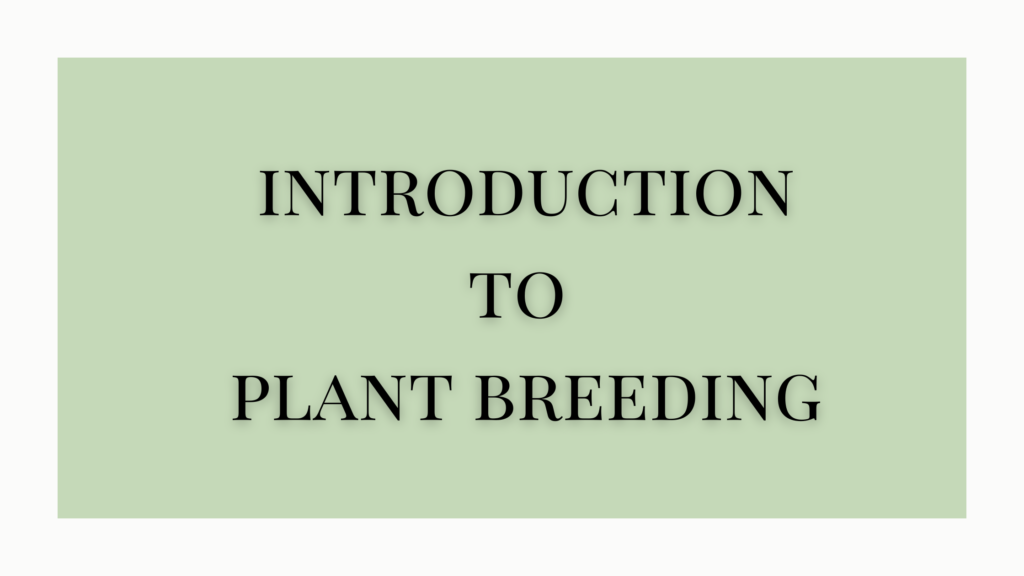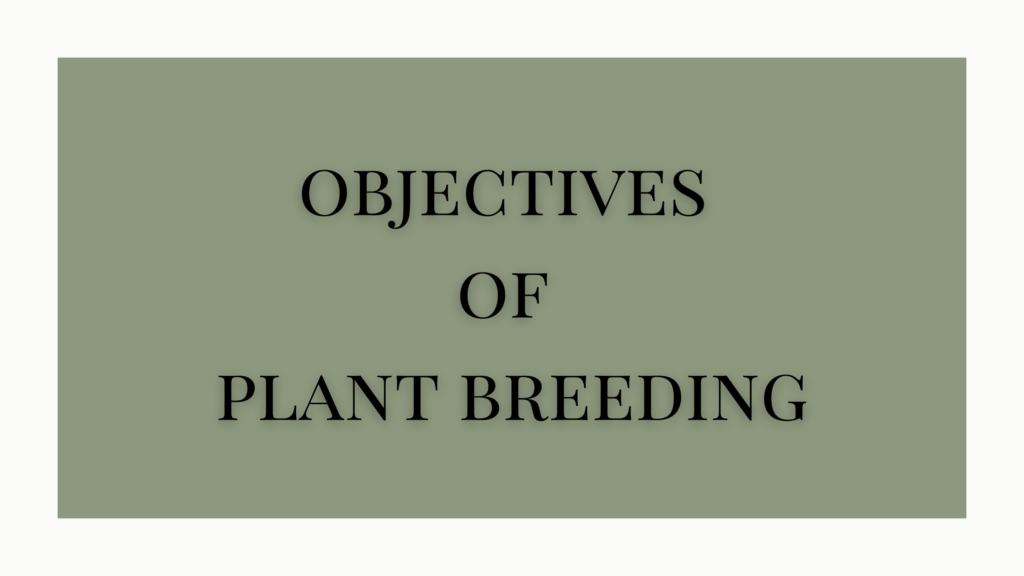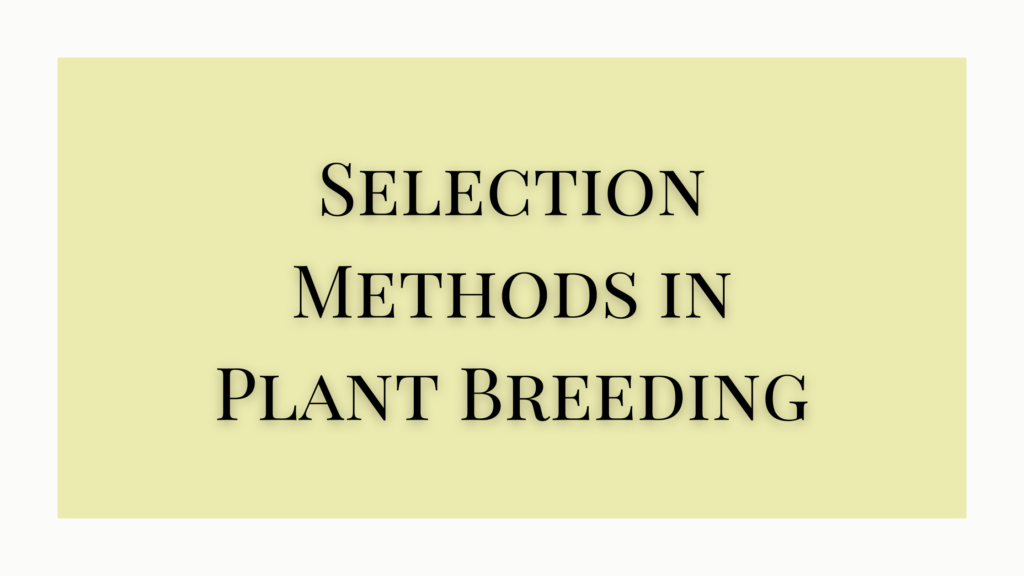Heterosis can be defined as the increase in vigor, growth, yield, and function of hybrids over their parents resulting from the crossing of individuals, unlike genetic constitutions. The superiority of hybrids or heterosis was first used by Shull (1914).
Hybrids usually show more vigor than either parent strains when considered separately. The superiority of the hybrid known as hybrid vigor shows itself as an improvement in general fitness, resistance to diseases, general hardiness, etc, and it differs in the luxurious growth which may be accompanied by improved fitness.
The discovery of heterosis and the practical application of heterosis in plant breeding took place almost simultaneously. Therefore a lot of scientific interest was generated in this phenomenon of heterosis has been taken advantage of since time immemorial. Ever since man has been using Mules – the hybrid between female donkeys and male horses for their stoutness and sturdiness.
Heterosis in Plant Breeding
It is generally observed that in naturally self-pollinated crops, repeated self-pollination gradually results in the decline of plant vigor, ie, the offspring produced by self-pollination are weak. In such cases, inbreeding is harmful.
In a few cases such as in peas, continuous breeding with the same type of plants has adverse effects. But in the majority of cases it has been found that if two dissimilar varieties are crossed, F1 hybrids, as a rule, are more vigorous than the parents.
Heterosis generally agrees that hybrid vigor describes only the superiority of hybrids over the parents, while heterosis also describes other situations. In some cases where the F1 hybrids are inferior to the parents may also be regarded as cases of hybrid vigor in the negative direction.
Hybrid vigor in artificial tobacco hybrids is reported by Kolreuter (1693). Subsequently, many workers reported hybrid vigor in a large number of plant species. These hybrids were produced from interspecific as well as intraspecific processes.
In 1876 Darwin found that the hybrids from unrelated plant types (intergeneric) are highly vigorous. Most of our present knowledge on heterosis comes from the work on maize. Maize is perhaps the most extensively studied crop species for heterosis.
Dr. G H Shull produced commercial corn which is cited as the best example. In natural conditions inbreeding in maize results in unhealthy offspring that are short-sized, less productive, less vigorous, homozygous, and uniform.
If two different inbred strains are crossed, F1 hybrids would be larger, sturdier, and more vigorous than the parents. Shull produced double hybrids in some of his hybrids by different inbreds.

The hybrid seeds obtained from the double cross were more vigorous and became commercial seeds. This phenomenon of heterosis has been observed in many important crops such as maize, jower, millets, wheat, barley, cucumber, onion, brinjal, tomato, sunflower, and many other plants.
Several varieties of vegetatively propagated plants like sugarcane, banana, and other fruit trees retain quality and vigor indefinitely.
Causes of Heterosis
Two theories explain the genetic causes of heterosis- The dominance hypothesis and over-dominance hypothesis.
Dominance hypothesis
The dominance hypothesis was proposed by Davenport in 1908 and later expanded by Bruce in 1910. In simplest terms, the dominance hypothesis suggests that at each locus, the dominant allele has a favorable effect while the recessive allele has an unfavorable effect. In homozygous cross, the harmful effects of ‘b’ and ‘d’ are not masked. In a heterozygous state, the deleterious effects of the recessive alleles are masked by their dominant allele.

The inbred parents can indefinitely reproduce themselves without any heterosis. On the other hand, heterozygous parents cannot reproduce themselves in the progeny. This heterozygosity gives way to heterosis. However, it may not be suitable for all conditions and varieties.
In heterozygous conditions, the harmful effects of the recessive alleles are masked by their dominant alleles. According to this theory, the increased vigor is due to the collection of larger numbers of dominant genes in hybrids than that of parents. Heterosis would depend on the genotype of the two parents.

The harmful effects of a, b, c, and d are hidden by A, B, C, and D. The progeny with a genotype AaBbCcDd, all with dominant genes are collected in one hybrid and this will show increased vigor than the parents.
It is important to note that maximum vigor is seen in F1 and it decreases gradually in F2, F3, F4, and other subsequent generations because of the segregation of factors.
Over dominance Hypothesis
This was proposed independently by Shull (1903) and East (1908). According to the over-dominance hypothesis, the heterozygote is superior to the homozygote and hybrid vigor increases with the increase in the degree of heterozygosity.
For example, the heterozygous A1A2 is superior to A1A1 and A2A2. The genes A1 and A2 govern different functions therefore the heterozygote is more vigorous than the inbreds.
Physiological And Biochemical Basis Of Heterosis
Cytoplasmic Nuclear Interaction Hypothesis
Some prominent breeders such as Shull, Levis, Michaelis, etc believe that the cytoplasm and nucleus interaction causes the heterosis. It is the result of increased metabolic activity and heterozygotes.
Greater initial capital (potential) hypothesis
This theory was put forward by Ashley (1930) based on his studies on tomato and maize. According to his theory, hybrid vigor is due to increased initial embryo size or greater initial capital.
Mitochondrial complementation
Sirkissan and Srivastava (1967) studied mitochondrial complementation in five inbreds of maize. They reported that mixing mitochondria from parents of heterotic crosses showed complementation in heterotic activity. Since mitochondria are the chemical powerhouses of cells, complementation at that level makes energy transfer in heterotic hybrids more efficient and hence expressed as heterotic vigor.
Biochemical Basis of Heterosis
Robbins (1941) selected two varieties of tobacco and studied the effects of vitamins on the growth rate of these varieties and those of their hybrids. He found that nicotinamide enhances the rate of growth in the red currant variety.
However, this vitamin does not affect the growth rate of the Johannisfeuer variety. On the other hand, pyridoxine enhances its growth rate but not of the red currant variety. Robbins found that neither nicotinamide nor pyridoxine had any effect on the rate of growth of a hybrid between these varieties.
These studies indicated that red currant can synthesize its own pyridoxine but not nicotinamide. Johanesfuer can synthesize its own nicotinamide but no pyridoxine and a hybrid between these can produce both vitamins.

The observation suggested that the expression of heterotic advance is an expression of the activity of the favorable combination of biochemical growth factors produced as the consequence of complementary gene action in hybrids.
The phenomenon of heterosis has been advantageously utilized for the improvement of crop plants. This provides an additional method of improving plant varieties. Hybrid vigor has been a success in maize breeding.
Hybrid maize plants bear long ears and the number of ears per plant is also more. Each ear has many more rows of larger and healthier seeds. Plants are disease and pest-resistant. The hybrid variety of bajra, bajra II, was released by the Indian Council of Agricultural Research. Hybrids of Sorghum show luxuriant growth, and good tillering and bear many more healthy seeds.
Heterosis has been noticed in castor seeds. The hybrid plants bear larger, heavier, and many more seeds per plant. The oil content of the seed is increased. Hybrids of cotton show better growth and long fibers. Hybrid vigor occurs in all self-pollinated as well as cross-pollinated plants. In cross-pollinated plants, it is easier to raise hybrids and to make full use of heterosis.
Vegetatively propagated plants are the basis for maintaining hybrid vigor because once achieved there is no change. The varieties of apple, mango, dahlia, etc are very popular and common. Many ornamental plants, fruit trees, vegetables, etc are the result of this process.
Manifestations And Applications Of Heterosis
Heterosis is the superiority of hybrids over the parents. This superiority may be in yield, disease and insect resistance, adaptability, general size or size of the specific parts, growth rate, enzyme activity, etc. The various manifestations of heterosis in plant breeding are given below.
- Increased yield: Heterosis is generally expressed as an increase in the yield of the hybrid. The yield may be measured in terms of grain fruit, seed, leaf, tubers, or the whole plant.
- Increased reproductive ability: The hybrids exhibiting heterosis show increased fertility and reproductive ability. It is often expressed as a higher yield of seeds, fruits, or other propagules.
- Increase in size and general vigor: The hybrids are generally more vigorous ie, healthier, faster growing, and larger than the parents. The increase in size is usually the result of an increase in the size of cells in various plant parts.
- Better quality: In many cases, hybrids show improved quality and utility of plant produce.
- Earlier flowering and maturity: The hybrid shows more efficiency in germination and growth. They flower earlier and show faster maturity than the parents. These qualities are desirable in many situations and crops.
- More resistance to insects and diseases.
- Greater adaptability: Hybrids are usually better adapted to environmental variations like cold, drought, etc, and grow faster than their parents.
Commercial Applications of Heterosis
Heterosis is observed in almost every crop species. This is why using heterosis in plant breeding has been one of the most successful strategies for higher-yield crops. Heterosis increases the rate of photosynthesis, thereby helping with the better yield.
Often the degree of heterosis is considerably high to permit its commercial exploitation. Heterosis is commercially used in the form of a hybrid or synthetic variety. Several self and cross-pollinated varieties have been commercially used.
A large number of plants are there where heterosis has been commercially exploited. Crops like maize, sugarcane, sunflower, jower, forage grasses and legumes, cotton, vegetables, fruit trees, etc are examples.




